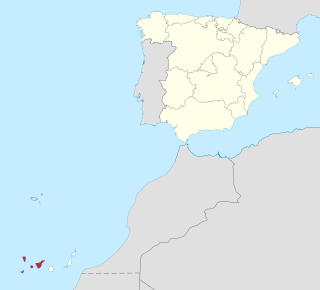
Province of Santa Cruz de Tenerife, also Province of Santa Cruz, is a province of Spain, consisting of the western part of the autonomous community of the Canary Islands. It consists of about half of the Atlantic archipelago: the islands of Tenerife, La Gomera, El Hierro, and La Palma. It occupies an area of 3,381 km2 (1,305 sq mi). It also includes a series of adjacent roques.

The Guanche were the historic indigenous inhabitants of the Canary Islands in the Atlantic Ocean some 100 kilometres (60 mi) west of the North African coast. They spoke the Guanche language. Believed to have been related to Berber languages of North Africa, it became extinct in the 17th century after the islands were colonized.
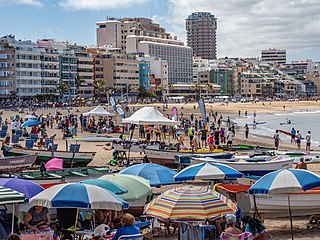
Las Palmas, officially Las Palmas de Gran Canaria, is a Spanish city and capital of Gran Canaria, in the Canary Islands, in the Atlantic Ocean.

Gran Canaria, also Grand Canary Island, is the third-largest and second-most-populous island of the Canary Islands, an archipelago off the Atlantic coast of Northwest Africa and is part of Spain. As of 2023 the island had a population of 862,893 that constitutes approximately 40% of the population of the archipelago. Las Palmas de Gran Canaria, the capital of the island, is the biggest city of the Canary Islands and the ninth of Spain.

Santa María de Guía de Gran Canaria is a town and a municipality in Las Palmas province of the Canary Islands. It is located on the north side of Gran Canaria island. Its population is 13,811 (2013), and the area is 42.59 km2 (16.44 sq mi).

The Pyramids of Güímar are six rectangular pyramid-shaped, terraced structures built from lava stone without the use of mortar. They are located in the district of Chacona, part of the town of Güímar on the island of Tenerife in the Canary Islands, Spain. The structures have been dated to the 19th century AD and they may originally have been a byproduct of contemporary agricultural techniques. These pyramids stand as high as 12 metres (39 ft).

Santa Brígida is a town and a municipality in the northeastern part of the island of Gran Canaria in the Province of Las Palmas of the Canary Islands. Its population is 18,791 (2013), and the area is 23.81 km². It is situated in the mountains, 13 km southwest of Las Palmas.
Telde is a town and a municipality in the eastern part of the island of Gran Canaria, Canary Islands, overseas (Atlantic) insular Spain.

Gáldar is a town and a Spanish municipality in the north of the island of Gran Canaria in the Province of Las Palmas in the Canary Islands. Its population is 24,227 (2013), and the area is 61.59 km2 (23.78 sq mi).
Below are notable events in archaeology that occurred in 1873.
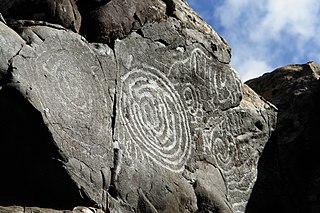
The Canary Islands have been known since antiquity. Until the Spanish colonization between 1402 and 1496, the Canaries were populated by an indigenous population, whose origin was Amazigh from North Africa.

Museo de la Naturaleza y Arqueología (MUNA), is a museum-based in Santa Cruz de Tenerife, Tenerife,. It contains many significant archaeological finds and is considered the best repository of objects from the Pre-Castilian Canary Islands. The museum also houses significant paleontological, botanical, entomological, and marine and terrestrial vertebrate collections, and is considered the best Natural Library of the Canary Islands.
Pintaderas are a form of stamp used by the pre-Hispanic natives of the Canary Islands. They were commonly made of fired clay. However, a number of wooden pintaderas have also been found. Most pintaderas come from archaeological sites in Gran Canaria, although natives from other islands in the Canarian archipelago used them too. Pintaderas were usually decorated with ornate geometric shapes, including zigzags, triangles, rectangles, squares and circles. These decorative motifs are similar to those found on pre-Hispanic Canarian pottery. Similar geometric patterns can also be seen in pre-Hispanic Canarian rock art
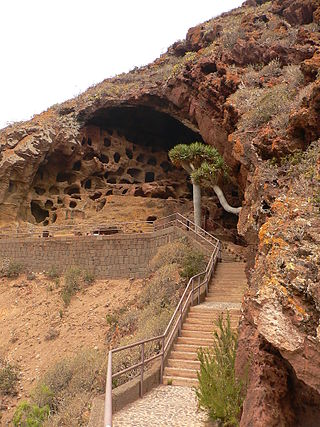
Valerón's "monastery" is an archaeological site on the Spanish island of Grand Canary, in the municipality of Santa Maria de Guia, on Valerón's cliff. It is the largest pre-Hispanic collective granary built before Roman times and used by the island's inhabitants until the conquest of the island at the end of the 15th century.

The Guayadeque ravine, in Spanish Barranco de Guayadeque, is a ravine-type valley located on the Spanish municipalities of Ingenio and Agüimes, in the province of Las Palmas on Grand Canary island, off the coast of Morocco.

The Four Doors site, also known as Montaña Bermeja, 'Vermillion Mountain', is a complex of caves in the south of the municipality of Telde, Gran Canaria.
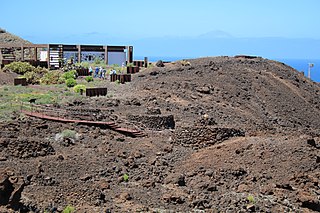
The El Maipés necropolis is an ancient burial site near Agaete on the Spanish island of Grand Canary, province of Las Palmas in the Canary Islands of the west coast of Africa.

El Museo Canario is an archeological museum in Las Palmas, the capital city of Gran Canaria in the Canary Islands. It is dedicated to the pre-colonial history of the Canary Islands.























